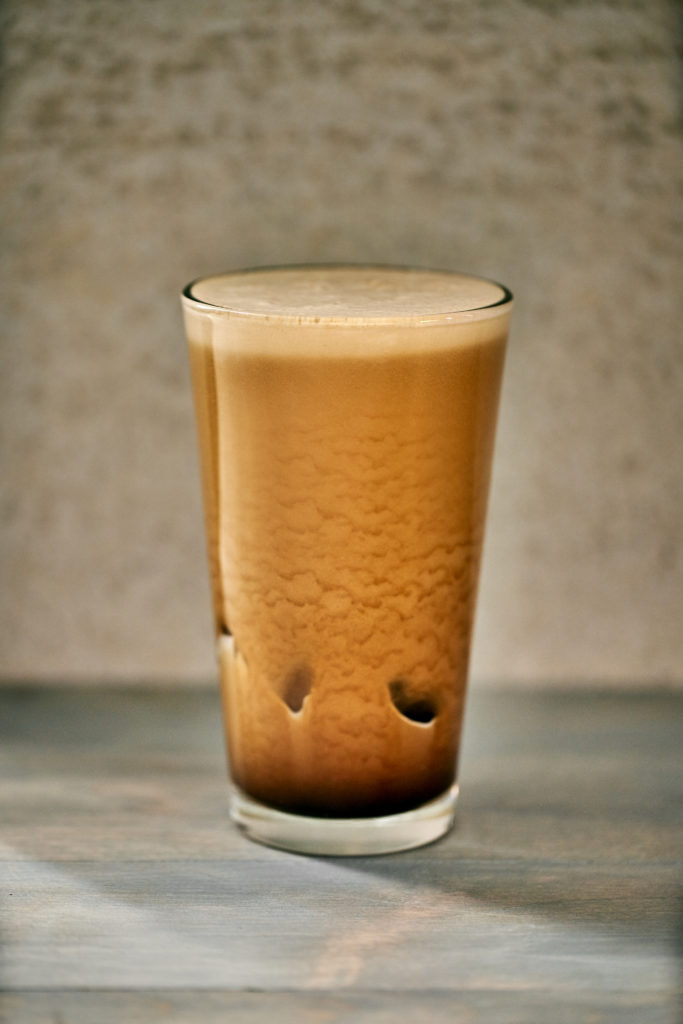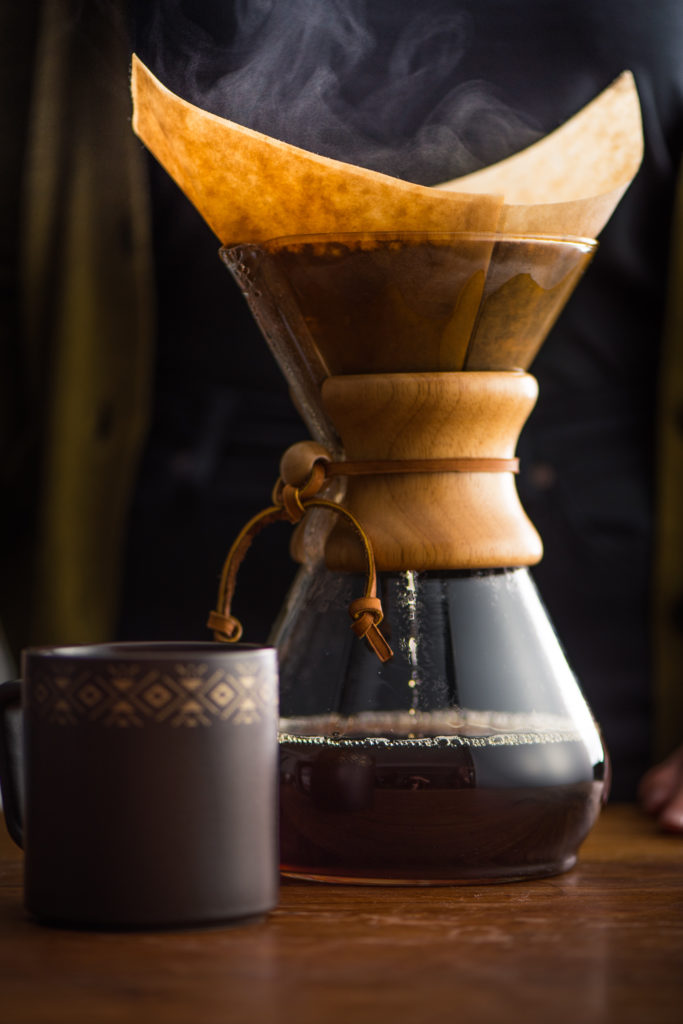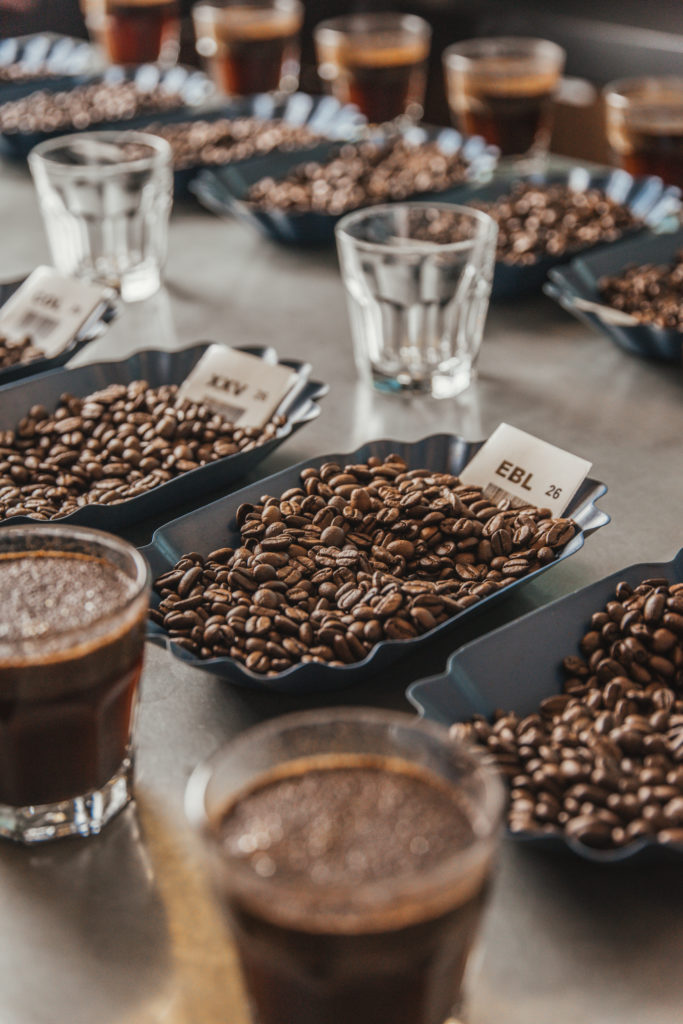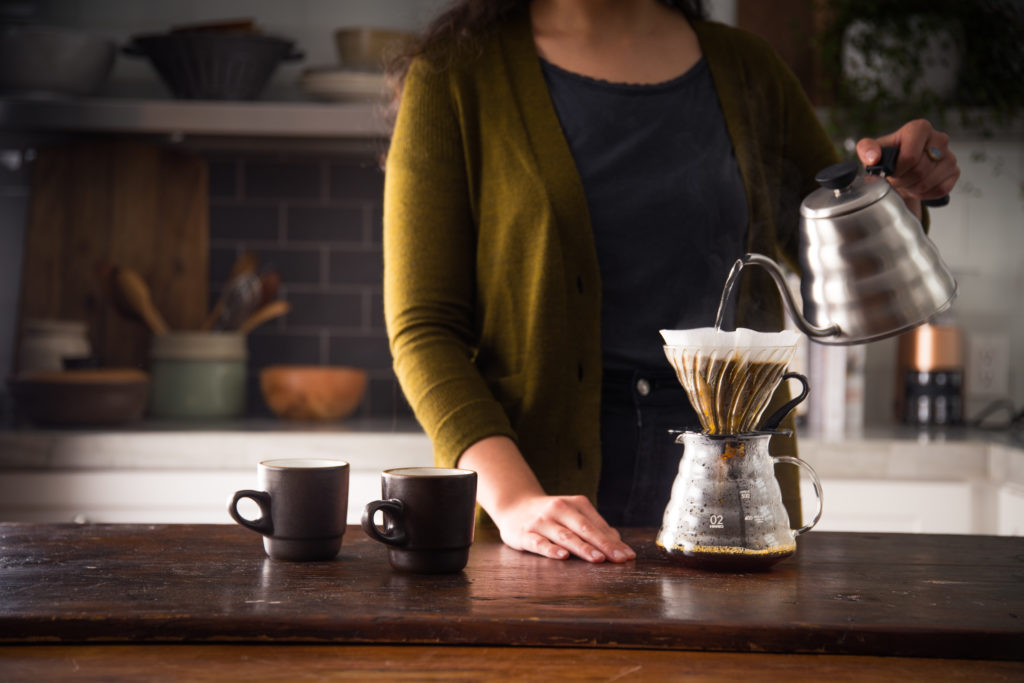
The Alphabet of Coffee
The Peet’s ABC's: an introduction to our language
A is for Arabica before anything else. The coffee species that dominates global trade, it’s typically grown at higher altitudes, offering the most refined flavors in coffee. Although named for Arabia, whence it first traded, its genetic birthplace is Western Ethiopia.
Acidity. Don’t think of this as a bad thing—it’s what creates the interesting sparkle in a coffee. It’s brightness as opposed to flatlining. It can be sour, yes, but it can also be just the thing you wake up for in the morning.
Aftertaste. A long-lasting effect on your palate. And when a coffee is delicious, the more of it you retain, the better. It’s also one of the main categories we evaluate for in the process of coffee quality control, or “cupping”–see below).
Aged Coffee is something Peet’s specializes in, thanks to Mr. Peet’s Dutch heritage. It’s when raw coffee has been stored for at least a year, changing its flavor profile. The tradition dates back to when coffees shipped from the Dutch colony of Indonesia on slow-moving sailing boats. The time it took along with the humidity exposure changed the coffee’s flavor.
Americano is the beverage produced when you pull a shot of espresso, then top it up with hot water to make a long cup.
A is also for Aroma. Ah, that heavenly thing. A coffee is formally evaluated by first sniffing the fragrance of its dry grounds, then the aroma that comes off those grounds when hot water has been poured over them.
B is for Beans, which is what we call coffee, although technically they are the seeds of the coffee cherry.
Body is the textural weight of coffee, the oils and dissolved solids that make it sit heavy in your mouth.
Bourbon. No, not the Southern whiskey you drink, but the old Arabica variety that first disseminated from the island of Reunion and spread coffee throughout the world. Known for its superior cup quality, sweet and bright.
C is for Caffeine, of course. The dictionary calls it a “bitter alkaloid”. We think of it as the pleasing pep in a coffee that picks us up on a down day.
C is for Cappuccino, fresh, silky foam poured, before it separates into liquid and froth, into just-pulled espresso at a strong ratio—four parts to one. Properly prepared, each tip of the cup delivers a delicious meld of coffee and dairy (or alt), never that black scald, slipping out from under its dry cap to bite you.
Chaff is the thin skin layer of a coffee bean that flakes off during roasting, except that bit caught in the crease, which appears as white specks when you grind your beans.
Cherry is not just a juicy Bing, it’s also what the coffee fruit is called. Though, unlike our springtime fave, it’s got two seeds in it, not just one.
Coffee is the fruit of the tree or shrub called genus coffea. There are many species, but usually we just talk about two of them, namely Arabica and Robusta. Coffea is a flowering tree, and the seeds—or beans—that we roast grow on its branches once the flowers have bloomed and fallen off.
Cold Brew coffee has, quite simply, been extracted with cold water instead of hot. That’s why the brewing time has to be extended, to as much as overnight, and the dose as much as doubled. Brewing cold and long brings out the sweet and smooth, with markedly less acidity, which is why we select exceptional East African coffees for our Baridi Blend—juiciness and aromatics to beat the chill.

Crust is the layer of coffee grounds that float to the top of a cup when water has been poured over them. ”Breaking the crust” is that coveted moment in the professional cupping process, when a spoon is used to agitate the grounds, releasing all their dizzying aromatics.
Cupping is that seemingly rude ritual coffee professionals use to evaluate a coffee’s quality, loudly slurping it, sloshing it, then spitting it out. (The Peet’s Coffee team spends hours a day cupping, both for quality control of raw coffee purchases, but also for what we roast and send out to customers. It’s our ultimate quality control measure. Our roasters adapt their technique according to what they taste, and no one is more adept.
D is for Decaffeination. The universal solvent water, supercritical C02, or other substances are all methods used to decaffeinate coffee, all of them equally industrial, all of them equally safe. Since all diminish slightly the body, acidity, and flavor of coffee, what really matters is what you start with. Peet’s buys beans from the same farms and co-ops as our “regular” coffees and ships them twice, out to the decaffeinator and back. The common practice is to purchase commodity qualities from the factory, already decaffeinated.
Dry Processing is when the coffee cherry is picked then left to dry in its entirety. Only then is it milled of its outer layers to reveal the green bean, or seed, inside. Over three weeks, this imparts flamboyantly fruity and sometimes wild flavors.
E is for Extraction. However you brew your coffee, the object is to extract all the good flavors from the beans, no more and no less. Every brew method extracts in slightly different ways.
E is also for Espresso, that quintessential Italian drink that forms the basis of our beloved lattes and cappuccinos. An espresso is prepared by forcing a small amount of water—around 40 mls—through a finely ground portion of coffee. It looks simple, but it’s an art form that has been raised to perfection and takes much practice to master.
Estate usually refers to a larger land holding, where coffee is farmed exclusively. This is in contrast to smallholdings, or coffee gardens, where farmers plant coffee trees as a cash crop in and amongst their vegetables or other food crops. The world’s largest estates, which can size up to thousands of acres, are in Brazil. By contrast, a smallholder farmer might only have a couple acres of mixed crops.
F is for Fermented. Fermentation is a necessary step in the washed coffee process, conducted in a pila, or open cement tank. The sticky fruit surrounding the coffee seed is consumed by local microbes (usually overnight) so that it can be washed off more easily the next day. When the coffee seed has been left to ferment too long, we consider the resulting funky taste a serious defect.
Fines. If your grinder is not top notch, you might find a lot of different particle sizes in your coffee. And as fines extract quicker than large particles when submerged in hot water, you can end up with over-extraction and some undesirable flavors.
Flash brewed. Also known as flash-chilled, or Japanese style iced coffee. All names for the same technique, which involves brewing a hot cup of coffee directly over ice cubes, for a cup that’s bright, clean, and complex, with balanced acidity.
Flat whites come to us from Australia (or is it New Zealand? The debate is out there.), where it generally means two shots of espresso topped with steamed milk. We hear it came about when cappuccinos used to be served with peaks of stiff milk froth, and customers wanted the drink without the peaks, hence flat.
Flavor is a combination of what you smell and taste. It’s a natural sensation that allows your nose and your mouth to enjoy coffee in a multidimensional way.
Floral is a fragrance—or flavor—often associated with truly fine coffees, like washed Ethiopian coffees that can reach to jasmine or orange blossom notes.
Fragrance is the smell of the dry particles when coffee has just been ground.
Fruity is how a coffee can smell or taste, especially when light-roasted. You can get a huge range, from apple to peach to lemon and ad infinitum.
G is for Gesha (or Geisha), an Arabica variety that shot to fame in the early 2000’s, the very first bags from Panama’s Hacienda Esmeralda coming to Peet’s. Its Ethiopian genetic provenance gives it an exceptionally refined floral tone, and it has repeatedly won cupping competitions and garnered growers huge prices.
Grading is the final step in the processing of green coffee before it is bagged and loaded into a shipping container at origin. Coffee beans are graded for size, density, color, and cup quality.
Green bean is what we call the raw coffee seed before it’s roasted.
Grinding is that critical step which breaks down roasted beans into small enough particles that infusion water can get at the flavor compounds and draw them out. Best done just before brewing.
Honey processed is when a coffee seed has been removed from its outer skin but is left to ferment with its fruit still surrounding it. The varying amounts of fruit left on denote its final name, as in red or black honey processed.
H is for Hulling. The coffee fruit is made of many layers that have to be removed in as many steps. Hulling is the step that takes the parchment skin from around the seed, revealing the green bean or raw coffee seed that we roast.
I is for Immersion when the coffee grounds are steeped in water, as in the French Press.
I is also for Infusion when water moves steadily through coffee grounds, like the pour over method used with a Chemex or drip coffee.

J is for Jamaica, home to a tiny quantity of coffee that Peet’s only sells once a year when it’s in season. Famous for its Blue Mountain Typica Arabica variety.
Java is a large Indonesian island that was planted with coffee very early on—in the 1600’s—by Dutch colonials. Its coffee was half of the world’s first blend: Mocha Java.
K is for Kona, Hawaii, the United States’ only real commercially grown coffee. It’s famous for its smooth, balanced coffee quality.
L is for Latte, or milk in Italian. It’s also the delicious espresso and steamed milk beverage that we serve in Peet’s coffeebars. It differs from a cappuccino in that it’s made with mostly steamed milk with a layer of microfoam.
Liquoring. Sounds risky, but it’s what cup testing for quality is sometimes still called. Today we call it “cupping,” the process whereby we taste coffees in a very proscribed ritual. It starts by sniffing the roasted coffee grounds’ fragrance, pouring water over them and waiting for a crust to form, breaking through the crust to evaluate the aroma, and finally tasting it. In tasting we evaluate for flavor, aftertaste, acidity, body, uniformity, balance, cleanliness, sweetness, and defects.
M is for Macchiato, referring to an espresso marked with a small dollop of milk foam on top. (Macchiato translates to “marked” in Italian.)
Melitta is the original pour over filter method of coffee preparation. Named for its German inventor, Melitta Bentz, who used her son’s blotting paper to filter the grounds out of her coffee. And the rest is history.
Milling is the process used to remove the parchment skin from around the coffee seed, or the husk off a dry processed coffee.
Mocha today means a chocolatey flavor in coffee, or even a hot chocolate with coffee in it. But originally, it meant coffee shipped from the Yemeni port of Al Makha, which had a naturally chocolatey flavor.
Monsooned coffee is the subcontinental Indian version of Indonesian aged. Back in the day, when it took forever to sail coffees to Europe and they were stored in the coastal monsoon humidity, beans changed composition and hence flavor.
Mucilage is the sticky fruit layer that surrounds the coffee seed.
Miel, Spanish for honey, is the more mellifluous term for same.
N is for Natural Processed, when the coffee cherry is picked and dried whole before being milled. Also called “unwashed” or “dry processed.”
O is for Organic, the practice whereby coffee is grown without synthetic pesticides, herbicides, or fertilizers, making for significantly lower yields. Organic standards are set by government (USDA) and apply universally.
“Origin” in coffee lingo refers to the countries in which coffee grows. A single origin coffee comes from one country of origin. An example: every bean in Peet’s Costa Rica comes from Costa Rica only.

P is for Parchment or Pergamino—whether in English or Spanish, the word for the pale, papery skin that surrounds the green coffee bean, after it has been fermented and washed, but before it’s been hulled and graded.
Peaberry is the little pea-shaped bean which, by a fluke of nature, grows solo inside a coffee cherry instead of the usual pair. Its flavor is concentrated, as it gets all the nutrition that would normally go to two seeds. Peaberries flourish in every field but are separated from their flat-sided brethren by custom (Kenya, Tanzania), or on occasion (most other countries).
Post-harvest Processing is everything that happens to the coffee cherry after it has been harvested or picked. Includes, for example, pulping, fermenting, washing, hulling, polishing, grading, etc.
Pour over is a manual coffee filter brewing method where you literally pour water over your grounds by hand, for the ultimate control over the rate of extraction. Examples include Melitta, Hario, Kalita Wave, or Chemex.

Press Pot, another term for the French Press, or Bodum, that we love to brew our coffee in, since nothing but a metal mesh gets between you, the drinker, and all the yummy flavors and oils in the brew.
Pulping is the start of the washed coffee process, in which the two coffee seeds are squeezed from the skin of the cherry. In high-quality production, it is also a sortation step; with the machinery set so that the hard, green, unripe fruits do not pass through the pulper, but are shunted off to a sub grade—nobody wants a grassy taste in their premium coffee.
Q is for Q-grade, a rigorous 6-day course offered by the Coffee Quality Institute that teaches students how to cup and evaluate quality coffees. A Q-grader is someone who has passed all 22 tests that comprise the course.
Quality is something all companies claim but few have the commitment to. Peet’s founded the quality coffee movement by sourcing the world’s finest beans, craft roasting them by means of expertly trained senses, and serving them exquisitely fresh in our coffeebars. Our grocery coffees are the same superb coffees, delivered directly to the market from our Roastery, and stamped with their roast date.
R is for Roast, of course. The process that transforms raw coffee from something that smells of almost nothing to a seductively fragrant bean with over 1000 different aromatic compounds. Peet’s is the past and present master of this craft, bringing to life one batch at a time, an artisan at the controls, using her senses to draw the utmost flavor from each intimately articulated coffee.
Robusta is the second largest commercially cultivated coffee species after Arabica. It’s known for its more robust size, hardiness, and caffeine content (hence the name), but also for a rough taste. It has never been on the menu at Peet’s but is growing in world production.
S is for Scorch,something that happens when beans are roasted in scorching hot air and the outside of the bean is burnt before the inside is fully developed.
Silverskin is the very last layer surrounding the green coffee bean. It’s an almost invisible membrane that is polished off to some extent before coffee ships from origin, but comes off in feathery light, white fluttering pieces when coffee is roasted.
Siphon is a wacky, picturesque brew method that involves two glass bulbs, a burner flame and a lot of patience since it can take a long time to brew. With a good burner, you get a fine, clear cup. With a tea lamp you get a Zen lesson in patience.
T is for Terroir. Everything that makes up the microclimate in which a coffee grows. Altitude, soil type, climate, etc. It imparts taste character: the same plant variety grown in different terroirs will absolutely taste different.
Tipping, like, scorching, can happen if you roast too hot, and little pieces from the ends of the bean literally pop off.
Typica is the tall, elegant-tasting heirloom Arabica coffee variety that populated much of the New World in the 1700’s, following a hundred year odyssey from Ethiopia to Yemen, India, Java, royal greenhouses in Amsterdam and France, and finally to South America and the Caribbean.
U is for Unwashed, another name for “dry” or “natural” processed coffee.
Variety or varietal, that is the question. The first is a noun and the correct word for the plant subspecies. The second is an adjective and technically the drink brewed from the variety. Makes more sense in wine.
W is for Washed coffee, which goes through a lengthy process. First its cherry skin is removed, then it’s fermented to loosen the fruit flesh. Next, it’s washed to remove the residue. Then it’s dried to the parchment stage. What happens after can be found under M for Milling….
Wet Hulling, a uniquely Indonesian way of processing coffee that creates intensely aromatic notes like pipe tobacco and can add thick body to a cup. Coffee beans are hulled free of their parchment skin before they are fully dried.
Wet Processed is another way to refer to washed coffee.
Y is for Yemen. There aren’t a lot of coffee words that start with Y, but as the country that first traded coffee around the world, and as a prized ingredient in the world’s first blend —Mocha Java—it’s worth calling it out.


